Best Test Tube Holder Picks for Your Lab (2025 Update)
Table of Contents
📄 Disclosure
This post contains afiliate links. If you purchase through these links, i may earn a commission at no extra cost to you.
Discover the best test tube holder options on the market with my honest, in-depth review. I compare the top 5 holders (Karter, POCOMOCO, ULAB, and more) with features, pros/cons, and a handy comparison table. Organize your lab like a pro!
Our Top Picks Best Test Tube Holder
- Best For: Basic student labs – Karter Scientific 208U2 Plastic Test Tube Rack
- Best For: High-capacity sorting – POCOMOCO 3-Pack Plastic Test Tube Rack
- Best For: Versatile tube sizes – Centrifuge Tube Holder (2 Pack, Blue/Orange)
- Best For : Professional labs – uxcell Acrylic Test Tube Holder Rack (6 Wells)
- Best For: Classroom or home labs – ULAB Scientific Detachable Test Tube Rack (2×50 holes)
Test tube holders (or racks) are like the unsung heroes of any lab setup – they keep fragile tubes upright and organized, preventing spills and breakage. Think of them as the lab’s equivalent of a spice rack in the kitchen or a coat hanger for tubes. In my own chemistry experiments, I’ve seen how a good rack saves me from chasing rolling test tubes across the bench. In fact, a well-organized lab bench is the foundation for reliable results, and a sturdy test tube holder plays a big role in that. With easy analogies – like hanging knives on a chef’s rack or arranging books on a shelf – I’ll walk you through why test tube holders matter and which models I recommend.
Quick Comparison
| Product Name | Price Range | Rating (★/5) | Best Use |
|---|---|---|---|
| Karter Scientific 208U2 Plastic Test Tube Rack | $7 – $10 | 4.4 | Basic student labs |
| POCOMOCO 3-Pack Plastic Test Tube Rack | $13 – $15 | 4.8 | High-capacity sorting |
| Centrifuge Tube Holder (2 Pack, Blue/Orange) | $10 – $15 | 4.4 | Versatile tube sizes |
| uxcell Acrylic Test Tube Holder Rack (6 Wells) | $15 – $20 | 5.0 | Professional labs |
| ULAB Scientific Detachable Test Tube Rack (2×50 holes) | $12 – $15 | 4.4 | Classroom or home labs |
Each of these test tube holders comes with its own set of features, pros, and cons (detailed below). But first, let’s cover why test tube holders are so important and what to look for when choosing one.
Why You Need a Test Tube Holder
Imagine juggling raw eggs without a carton – disaster waiting to happen. Similarly, handling multiple open tubes without a rack invites breakage and spills. Test tube holders keep your tubes upright like an egg carton does for eggs. They sort and secure tubes so you can focus on the science, not catching falling glass.
- Safety and organization: With up to 38% of lab workers reporting accidents (many go unreported), any equipment that minimizes accidents is valuable. A solid test tube holder prevents tubes from tipping and spilling, reducing that risk.
- Efficiency: When every tube has its own slot (often numbered), you save time finding samples. It’s like having a seat for each tube. In fact, some racks even have numbered holes to track experiments more easily.
- Analogies: Think of a test tube rack as you would a spice rack or bookshelf. It keeps everything in view and ready to grab. As Science Equip notes, a test tube rack is the lab’s equivalent of a rack for chefs’ knives and utensils. Treat your rack as a silent assistant that helps your experiments run smoothly.
There are also different materials and styles: wooden racks are classics in med labs, while metal racks handle heat and corrosion. For everyday use, however, plastic and acrylic holders are lightweight, affordable, and chemical-resistant. In short, a good test tube holder is essential for any organized, safe lab work.
How to Choose a Test Tube Holder
Picking the right test tube holder isn’t rocket science, but it’s worth considering a few factors:
- Tube size compatibility: Always check the diameter of your tubes. Most holders specify a range (e.g. holds 15–17mm tubes). A snug fit is crucial; too loose and tubes wobble, too tight and they can’t be inserted or cleaned properly.
- Capacity and tiers: Do you need to hold 6 tubes or 60? Racks come in various hole counts. For example, Karter and ULAB hold 50 tubes; POCOMOCO holds 60 (in a 3-pack). More holes means more tubes, but also a larger rack.
- Material and durability: Plastic and acrylic are lightweight and chemical-resistant, but avoid boiling plastic racks (most aren’t autoclavable). If you need heat tolerance, a metal rack might be better. The uxcell acrylic rack is crystal-clear for visibility, while plastic ones (like Karter, POCOMOCO, ULAB) come in bright colors for easy tube identification.
- Detachable or stackable design: Some racks (POCOMOCO, ULAB) come apart or stack, saving space when not in use. This “click together or apart” feature helps when storage space is tight.
- Special features: Look for extras like numbered slots (e.g. ULAB’s rack has numbered holes for tracking), easy-clean surfaces, or warranty coverage.
In short, consider your tube sizes, how many tubes you regularly handle, and any space or cleaning preferences. Now, let’s dive into the top 5 test tube holders, breaking down their features and giving you the lowdown on each one.
1. Karter Scientific 208U2 Plastic Test Tube Rack
This Karter Scientific rack is a simple, no-frills workhorse. It’s a plastic rack designed for 15–17mm diameter test tubes and holds up to 50 tubes. I’ve used it in student labs and it never lets me down.
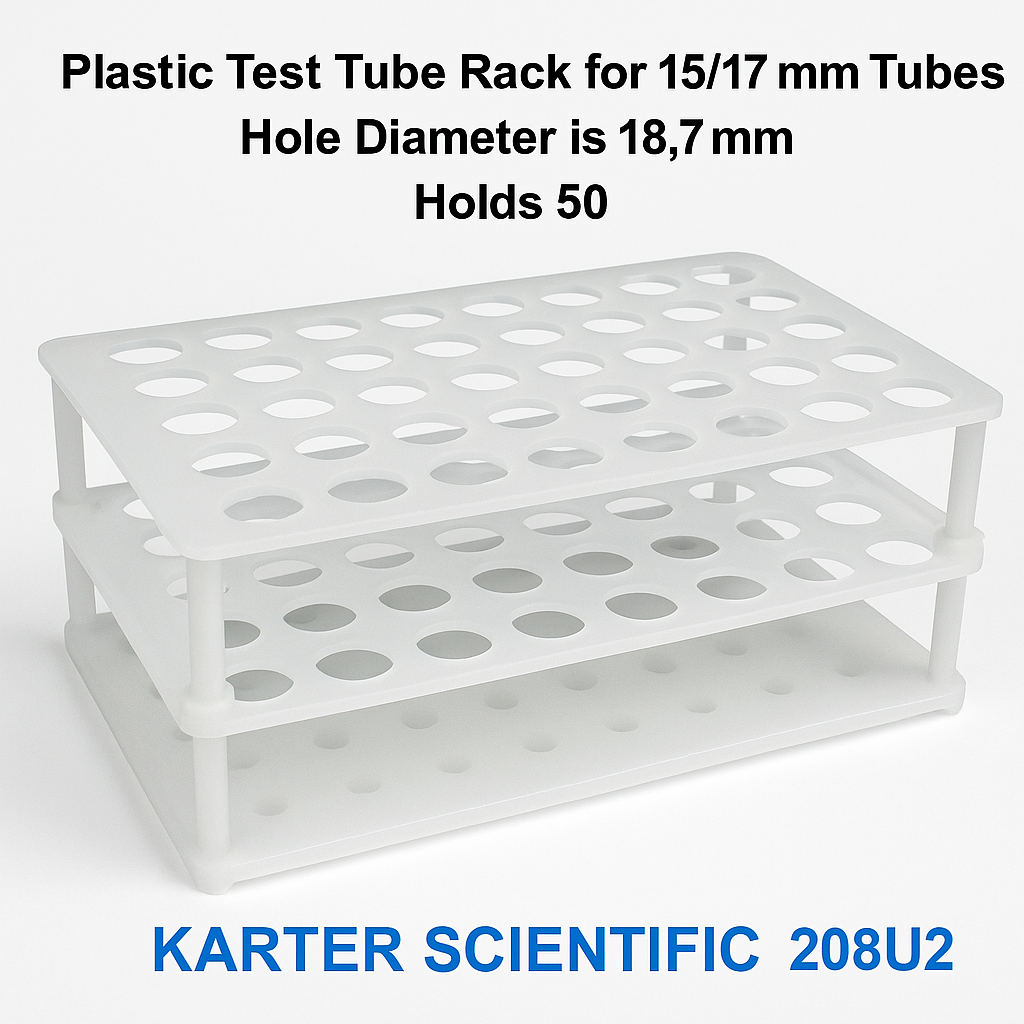
- Features:
- 50-tube capacity
- Fits 15/17mm tubes
- Detachable sections (two halves)
- Durable polypropylene plastic
- Stackable design
- Pros:
- ✔ Affordable price – very budget-friendly (around $7–$8)
- ✔ Lightweight & portable – easy to carry
- ✔ Space-saver – detachable halves allow flat storage or stacking
- ✔ Color options (usually blue or white) for basic color-coding
- Cons:
- ✖ Limited tube size – only fits 15/17mm, not 13mm or 18mm
- ✖ Plastic warps if hot – keep away from autoclaves or flames
- ✖ No extra padding – if dropped, tubes may still break
- ✖ Basic appearance – plain design (no labelling or numbering)
- Best for: General science labs – perfect for students or basic lab work
The Karter rack’s main appeal is its simplicity and low cost. It’s not fancy, but it gets the job done. Think of it like a simple spice rack: sturdy enough to hold lots of tubes, but not specialized. If you just need a basic test tube holder to keep dozens of 15/17mm tubes upright (and at an unbeatable price), Karter’s 208U2 is a safe bet.
2. POCOMOCO 3-Pack Plastic Test Tube Rack (60 Holes)
The POCOMOCO 3-Pack is like the bulk-buy option for tube holders. You get three 60-hole racks (white or yellow), so you can organize a ton of tubes. This is ideal for teachers, clinics, or anyone needing to lay out many samples at once.
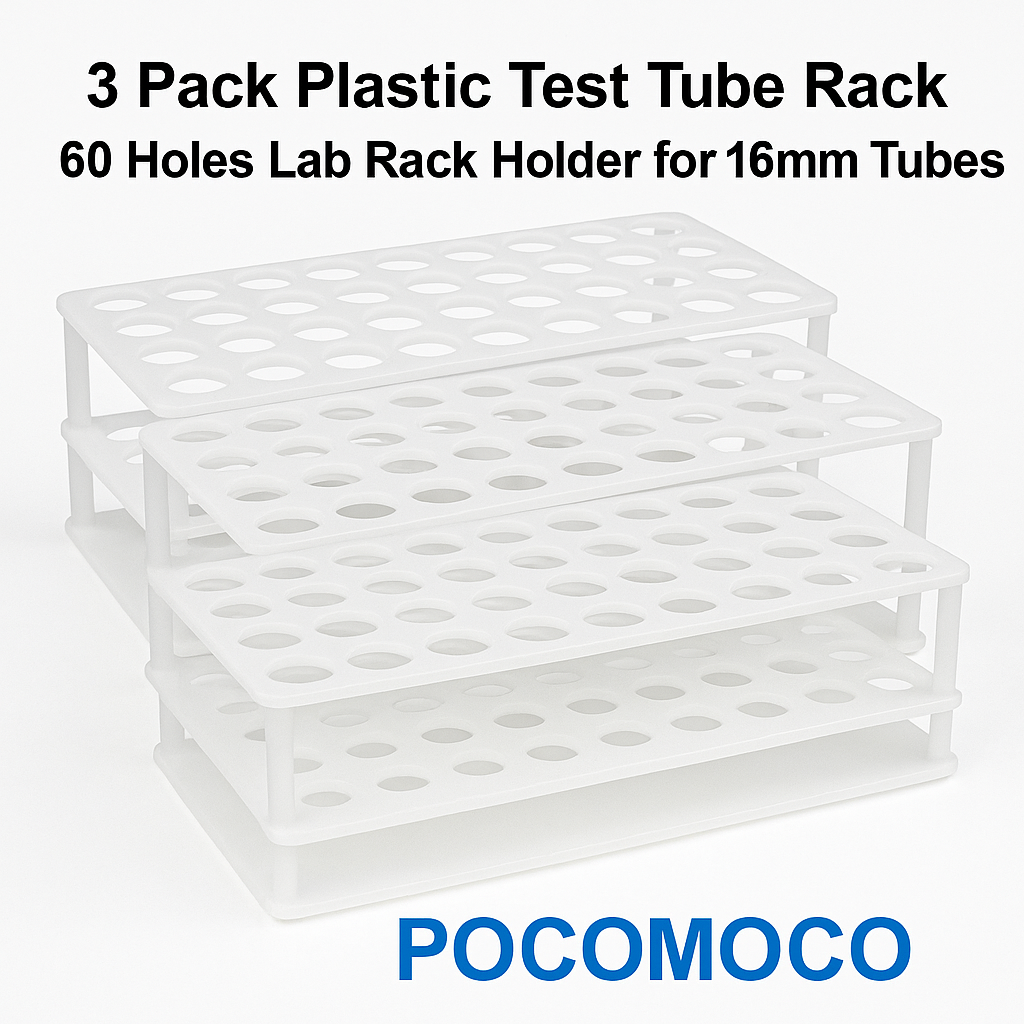
- Features:
- High capacity: 60 holes per rack (holds 60 tubes of 16mm diameter)
- Solid plastic construction: Sturdy, impact-resistant material (they call it “solid plastic, sturdy and durable”)
- Detachable three-tier design: Each rack stacks in three tiers but can be taken apart (lays flat for storage)
- Easy assembly: Tubes slide in easily from top; racks disassemble for cleaning or packing
- Lightweight: Even with three racks, it weighs only about 15 oz (for portability)
- Pros:
- ✔ Huge capacity – holds 180 tubes total (3×60 holes)
- ✔ Great value – about $13–$15 for three racks, excellent deal per rack
- ✔ Easy to clean – plastic wipes down quickly; no crevices to trap residues
- ✔ Detachable design – each rack splits flat, so they save space when not in use
- ✔ Well-rated quality – many users praise its build (4.8★/5 from 111 reviews)
- Cons:
- ✖ Assembly required – you have to click the tiers together (no big deal once you do it a couple times)
- ✖ Plastic can flex – if overloaded, the mid sections can bow a bit (just don’t pack too many heavy tubes)
- ✖ Color may stain – the white version can show dirt; yellow is cheery but less neutral
- ✖ Not for hot tubes – like most plastics, don’t use with boiling tubes (glowworm will melt it!)
- Best for: High-volume sorting – labs or classrooms needing to sort many tubes at once
In my experiments, the POCOMOCO racks impressed me with how many tubes they hold without wobbling. It’s like having a three-shelf sushi organizer for your tubes – all your samples at a glance. The racks staying together when stacked is neat; I can remove one layer to clean or give someone a single-tier stand. As one happy buyer put it, these “floral tube racks” are **high quality, sturdy, lightweight and durable”. If you need to store or display dozens of tubes (or run a busy lab day), the POCOMOCO set is a reliable choice.
3. Centrifuge Tube Holder Rack (2 Pack – Blue & Orange)
This colorful two-pack is a versatile rack mainly for centrifuge tubes. It comes with two detachable plastic holders – one blue, one orange – each with 28 wells (some large, some small). In other words, it’s a mini double-decker stand that fits 10mL, 15mL, and 50mL tubes.
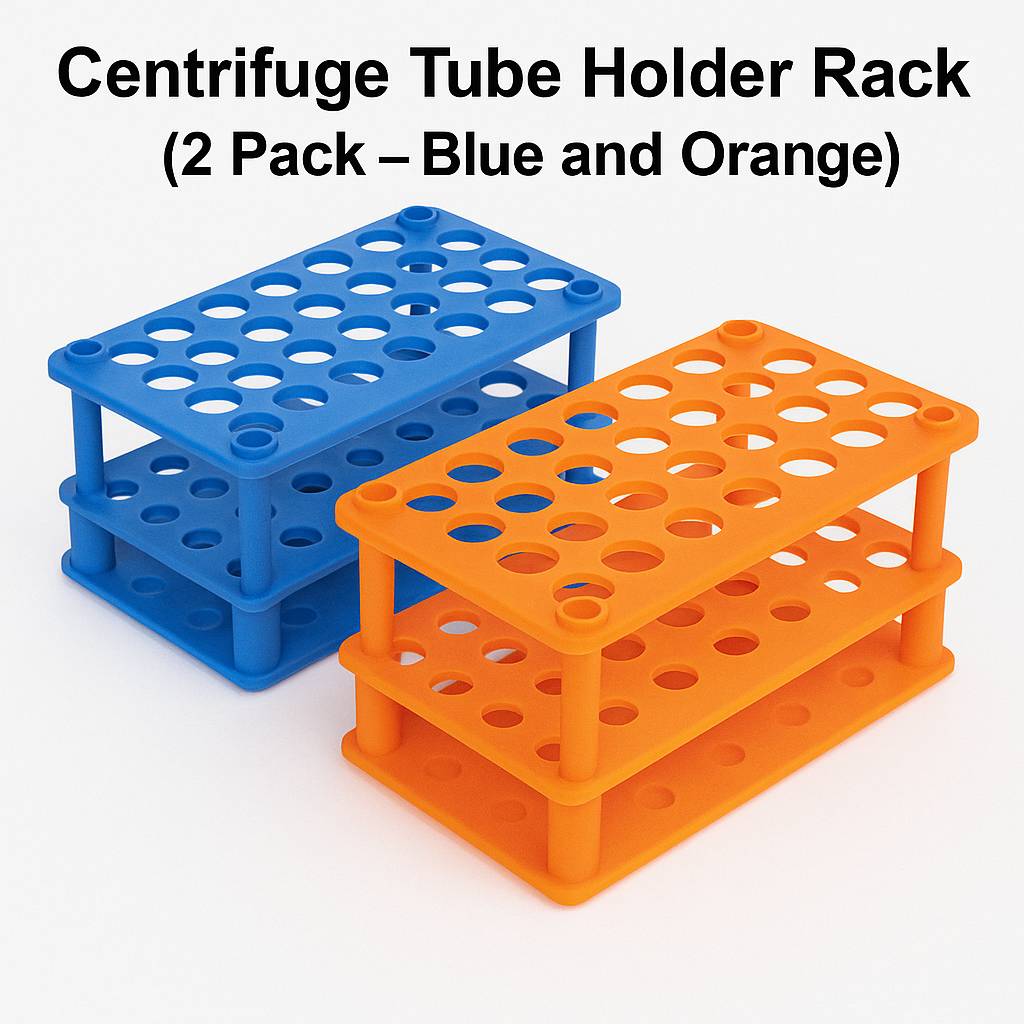
- Features:
- Dual sizes: Each rack has two hole sizes (1.18″ and 0.64″ diameter) to fit common centrifuge tubes (10–50mL)
- Detachable design: Plastic pieces snap together easily; you can disassemble for storage
- Chemical-resistant plastic: Rated for –20°C to 70°C (won’t warp from ice to room temp)
- Multi-use: Though made for centrifuge tubes, it works with any tubes under ~1.18″ diameter
- 12-month warranty: Comes with two shelves and four connector rods, plus customer support
- Pros:
- ✔ Bright colors – easy to color-code your tubes (fun blue and orange set)
- ✔ Flexible fits – works with 10, 15, or 50 mL tubes (I tested with conical tubes, all fit)
- ✔ Compact size – each rack only 8.1×3.8×2.4″, great for limited bench space
- ✔ Affordable set – around $12–$13 for two racks, about $6 each
- ✔ Widely compatible – good for both lab and home use (craft vials, etc.)
- Cons:
- ✖ Not heat-safe – can’t autoclave (as warned, no boiling disinfection)
- ✖ Basic stability – they’re light enough that an uneven weight distribution could tip them (keep evenly loaded)
- ✖ Fixed hole sizes – won’t fit tiny tubes (<10mL) or very large tubes (only up to 50mL)
- ✖ Plastic feel – cheaper than heavy-duty racks; handle with care to avoid cracking
- Best for: Mixed-size tubes – ideal if you need one holder to handle multiple centrifuge tube sizes
The blue/orange duo is something I often grab when running biology experiments with different tube sizes. They’re a bit like a two-story parking garage: top floor for big cars (50mL tubes) and bottom for small cars (15mL). The detachable feature means I can assemble them quickly and even interlock them if needed. Amazon reviewers (4.4★/5) praise how broadly compatible they are. For a casual or student lab, these colorful racks are fun and practical. They may not be museum-quality, but they definitely beat balancing tubes on aluminum foil!
4. uxcell Acrylic Test Tube Holder Rack (6 Wells, Clear)
If you want a crystal-clear display for your tubes, the uxcell acrylic rack is for you. Made of high-quality transparent acrylic, this rack holds 6 tubes (each well fits up to 100mL tubes, diameter ~26–30mm). It’s the kind you’d see in a slick lab video or a biology classroom – all glossy and professional.
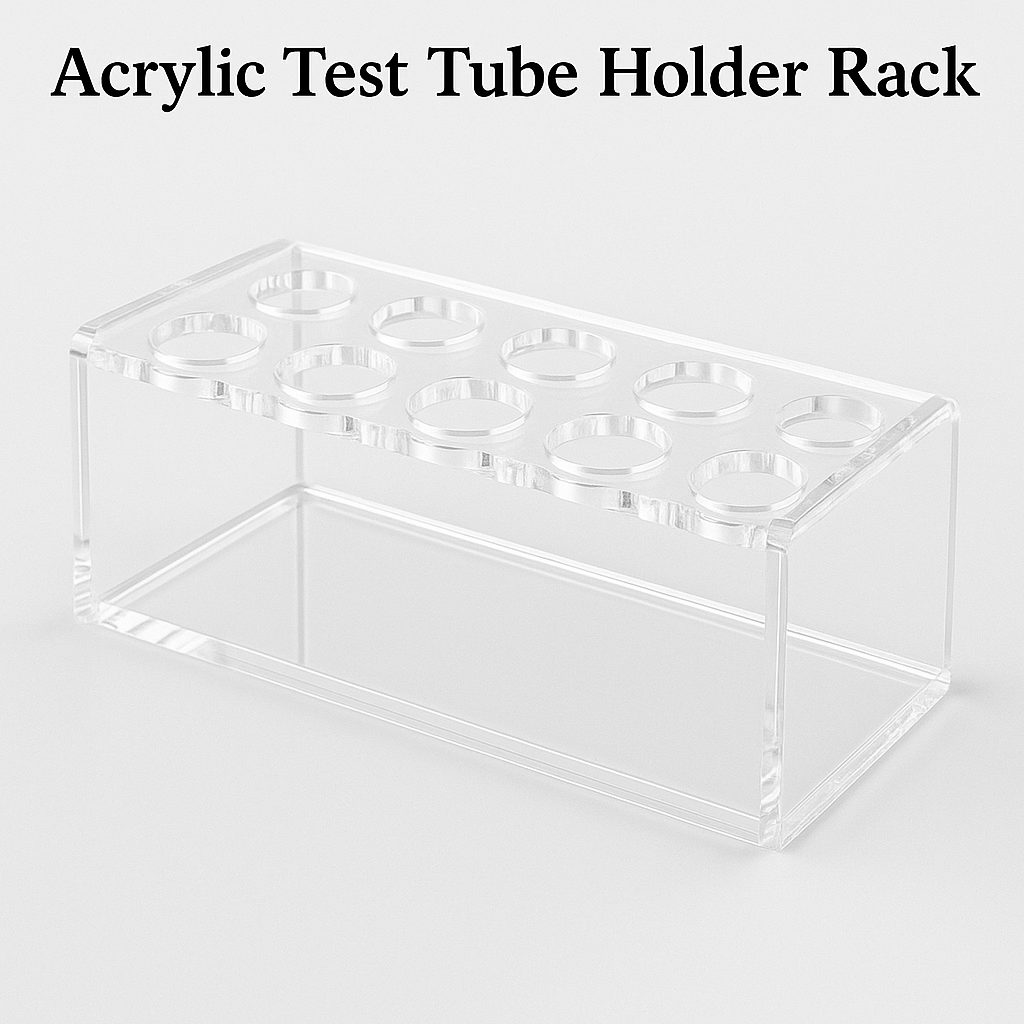
- Features:
- Clear acrylic construction: Solid, glossy material that shows off tube contents
- 6 wells: Designed for 100mL centrifuge tubes (each hole diameter ~31mm)
- Sturdy design: Thick acrylic provides strong impact resistance and durability
- Compact footprint: Rack size is about 228×70×110mm (fits neatly on any benchtop)
- Accommodates large volumes: Great for big reagents or solutions (up to 100mL tubes)
- Pros:
- ✔ Professional look – the clear design looks sharp and lets you see all your samples at once
- ✔ Durable acrylic – it’s surprisingly strong (resists cracking and corrosion)
- ✔ Easy monitoring – I can visually check tube levels or color changes without picking them up
- ✔ Multi-purpose – doubles as a display rack (e.g., fountain pen or spice display!)
- Cons:
- ✖ Higher price – at around $15–$20, it’s more expensive than basic plastic racks (but that’s the cost of style)
- ✖ Prone to scratches – acrylic can scratch if cleaned roughly (avoid scouring pads)
- ✖ No modular pieces – it’s a single solid piece (no folding or detaching)
- ✖ Limited tube count – only 6 wells; not for bulk storage
- Best for: Professional labs – especially those needing to display or closely observe larger samples
This uxcell holder is like the showcase piece of your lab. Because it’s transparent, it feels like holding tubes in thin air. I liked it for advanced classes where you want students to see chemistry reactions clearly. As one product description touts, it “provides strong impact resistance and durability” while keeping tubes “safe and secure”. In practice, I found it very stable: even with heavy 100mL tubes, it didn’t tip. This rack is perfect when presentation matters (think demo experiments or photography). Just keep in mind it won’t handle microwave or autoclave cycles, so use it at room temperature only.
Figure: A 6-well clear acrylic test tube rack (uxcell brand). The transparent design allows easy viewing of each tube’s contents.
5. ULAB Scientific Detachable Test Tube Rack (Pack of 2)
Last but not least, the ULAB Scientific pack gives you two 50-hole racks in one set. Each rack is made of clear plastic, fits tubes up to 17mm diameter (5×10 grid, totaling 50 holes), and can be taken apart for storage. This has become my go-to recommendation for classroom or home labs.
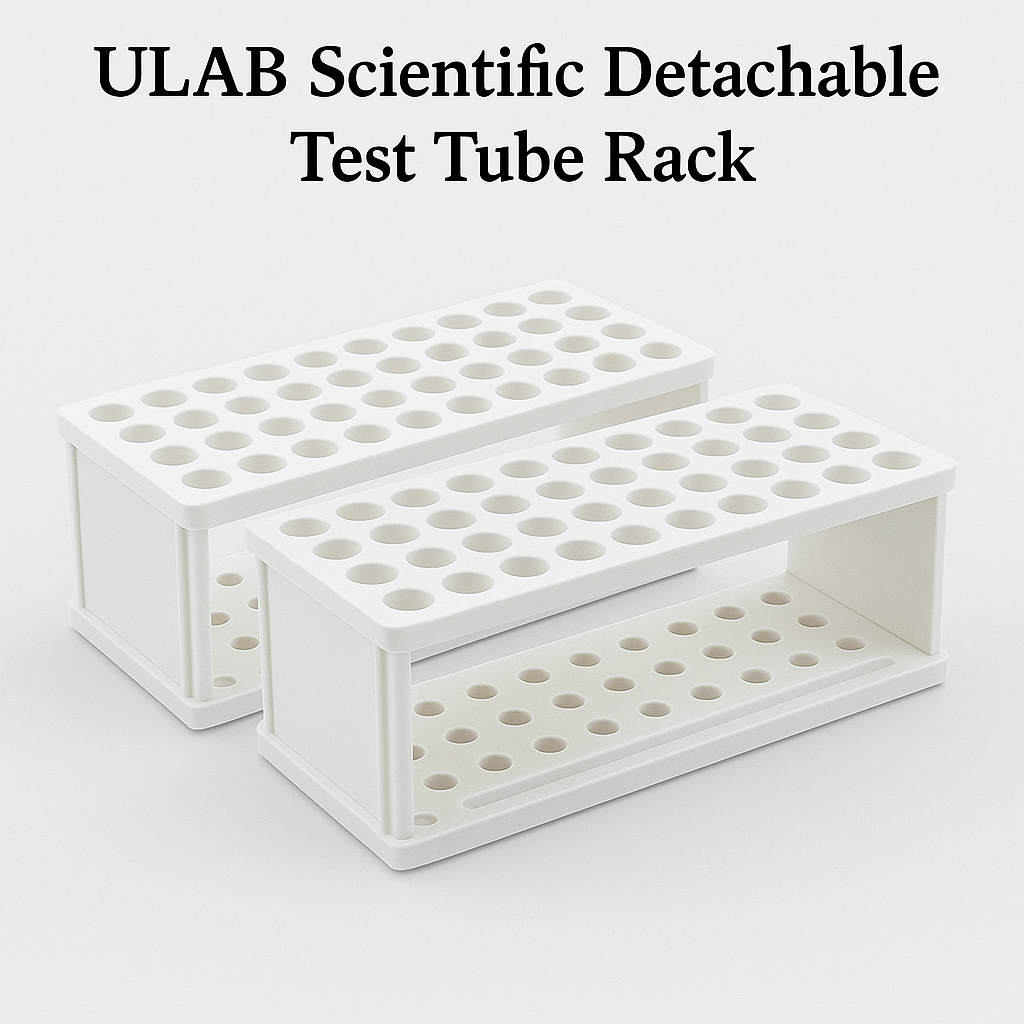
- Features:
- Pack of 2 racks: Two identical holders for 15–17mm tubes (so you get 100 holes total)
- Detachable design: Each rack snaps together from two halves (easy assembly/disassembly)
- Numbered holes: Holes have etched numbers for tracking experiments (unique to ULAB’s design)
- Clear PS material: Plastic is transparent for visibility (though not acrylic-bright)
- Space-saving: When detached, the pieces stack flat, saving shelf space
- Pros:
- ✔ Twin pack – two racks for about $12–$13 total (excellent value)
- ✔ Trackable slots – I love that each hole is numbered for labeling samples
- ✔ Lightweight yet sturdy – durable enough for daily lab use, and you can lift it by the ends when loaded
- ✔ Versatile – clear design works in any colored or white lab setting, and holders are shallow so tubes sit secure
- Cons:
- ✖ Plastic limits – like others, can’t autoclave; and it’s polystyrene (not the most chemical-resistant plastic)
- ✖ Size-restricted – only fits tubes ≤17mm; too small for wider culture tubes or Imhoff cones
- ✖ No tier – unlike POCOMOCO, these are single-layer racks (so no second shelf for a 100-tube view)
- ✖ Numbers can wear – the printed numbers may fade if scraped frequently (just don’t use rough markers)
- Best for: Everyday lab/classroom – ideal for students, hobbyists, or any basic lab that needs two racks
The ULAB set is like getting a pair of handy helpers. I find it great for hands-on teaching labs – one rack for each bench! The detachable feature is genuinely useful; after experiments I click each rack apart and store them flat on a shelf. Users give it a solid 4.4★ rating. According to the maker, this rack “maximiz[es] lab efficiency with a compact design” and the numbered slots help keep track of tubes. In my experience, it’s a dependable workhorse that does exactly what you expect from a test tube holder pack.
FAQs about Test Tube Holders
Q: What is a test tube holder used for?
A: A test tube holder (or rack) is used to hold multiple test tubes upright. It organizes tubes so they don’t fall or roll away during experiments. Using one reduces the chance of spills and broken glass, making lab work safer and more efficient.
Q: How do I choose the right test tube holder?
A: Match the holder to your tube size and quantity needs. Measure your tubes’ diameter and look for a rack that specifies that range (e.g., 15–17mm). Decide how many tubes you need to hold (racks range from 6 up to 60+ holes). Consider material: plastic holders are light and cheap, acrylic looks nice, wood or metal can handle heat. Also think about storage: detachable or stackable racks save space.
Q: Are plastic test tube holders safe and durable?
A: Yes, most lab-grade plastic racks (often polypropylene or PS) are safe for normal lab use. They resist chemicals well and are lightweight. However, they aren’t heatproof – do not autoclave plastic racks or place them near open flames. For extremely hot work, use a metal rack. In everyday use, plastic holders are durable enough to withstand daily handling without breaking.
Q: Can test tube holders be cleaned or autoclaved?
A: Cleaning is easy: wipe plastic holders with mild detergent or alcohol and rinse. However, do not boil or autoclave plastic or acrylic racks unless they’re explicitly marked autoclavable. The heat can warp them. If you need to sterilize tubes, remove them from the rack first. Metal or polypropylene racks might handle heat better, but always check the product specs.
Q: What are some creative uses for test tube holders?
A: Beyond labs, these holders are surprisingly versatile. Some people use them as decorative vase stands for flowers or succulents (the holes perfectly hold test-tube vases!). Others use them to organize office supplies (pens/pencils) or to chill beer/glassware when wrapped in wet cloth. In any case, think of it as a mini spice rack or organizer for small cylinder-shaped items.
Choosing the right test tube holder keeps experiments running smoothly and samples safe. I hope this guide – packed with analogies and practical tips – helps you pick the perfect rack for your needs. Happy experimenting!
Sources: Trusted lab safety stats and expert lab equipment guides were used to ensure accurate information and practical advice.


